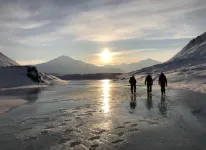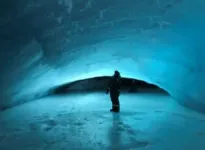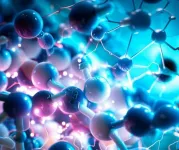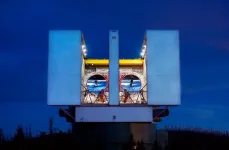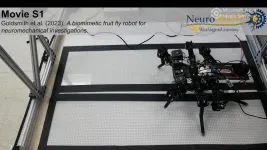(Press-News.org) As the Arctic warms, shrinking glaciers are exposing bubbling groundwater springs which could provide an underestimated source of the potent greenhouse gas methane, finds new research published today in Nature Geoscience.
The study, led by researchers from the University of Cambridge and the University Centre in Svalbard, Norway, identified large stocks of methane gas leaking from groundwater springs unveiled by melting glaciers.
The research suggests that these methane emissions will likely increase as Arctic glaciers retreat and more springs are exposed. This, and other methane emissions from melting ice and frozen ground in the Arctic, could exacerbate global warming.
“These springs are a considerable, and potentially growing, source of methane emissions — one that has been missing from our estimations of the global methane budget until now,” said Gabrielle Kleber, lead author of the research who is from Cambridge’s Department of Earth Sciences.
Scientists are concerned that additional methane emissions released by the Arctic thaw could ramp-up human-induced global warming. The springs the researchers studied hadn’t previously been recognized as a potential source of methane emissions.
Kleber spent nearly three years monitoring the water chemistry of more than a hundred springs across Svalbard, where air temperatures are rising two times faster than the average for the Arctic. She likens Svalbard to the canary in the coal mine of global warming, “Since it is warming faster than the rest of the Arctic, we can get a preview of the potential methane release that could happen at a larger scale across this region.”
Professor Andrew Hodson, study co-author from the University Centre in Svalbard said, “Living in Svalbard exposes you to the front-line of Arctic climate change. I can’t think of anything more stark than the sight of methane outgassing in the immediate forefield of a retreating glacier.”
Previously, research has centred on methane release from thawing permafrost (frozen ground). “While the focus is often on permafrost, this new finding tells us that there are other pathways for methane emissions which could be even more significant in the global methane budget,” said study co-author Professor Alexandra Turchyn, also from Cambridge’s Department of Earth Sciences.
Hodson added, “Until this work was conducted, we didn’t understand the source and pathways of this gas because we were reading about studies from completely different parts of the Arctic where glaciers are absent.”
The methane-delivering springs they identified are fed by a plumbing system hidden beneath most glaciers, which taps into large groundwater reserves within the underlying sediments and surrounding bedrock. Once the glaciers melt and retreat, springs appear where this groundwater network punches through to the surface.
The researchers found that methane emissions from glacial groundwater springs across Svalbard could exceed 2,000 tonnes over the course of a year — which equates to roughly 10% of the methane emissions resulting from Norway’s annual oil and gas energy industry.
This source of methane will likely become more significant as more springs are exposed, said Kleber, “If global warming continues unchecked then methane release from glacial groundwater springs will probably become more extensive.”
Glacial groundwater springs aren’t always easy to recognize, so Kleber trained her eye to pick them out from satellite images. Zooming in on the areas of land exposed by the retreat of 78 glaciers across Svalbard, Kleber looked for tell-tale blue trickles of ice where groundwater had leaked to the surface and frozen. She then travelled to each of these sites by snowmobile to take samples of the groundwater at locations where the ice had blistered due to pressurized water and gas build up.
When Kleber and the team profiled the chemistry of the water feeding these springs, they found that all bar one of the sites studied were highly concentrated with dissolved methane — meaning that, when the spring water reaches the surface, there is plenty of excess methane that can escape to the atmosphere.
The researchers also identified localized hotspots of methane emissions, which were closely related to the type of rock from which the groundwater emerges. Certain rocks like shale and coal contain natural gases, including methane, produced by the breakdown of organic matter when the rocks formed. This methane can move upwards through fractures in the rock and into the groundwater.
“In Svalbard we are beginning to understand the complex and cascading feedbacks triggered by glacier melt — it seems likely that there are more outcomes like this which we have yet to uncover,” said Kleber.
“The amount of methane leaking from the springs we measured will likely be dwarfed by the total volume of trapped gas lying below these glaciers, waiting to escape,” said Hodson, “That means we urgently need to establish the risk of a sudden increase in methane leakage, because glaciers will only continue to retreat whilst we struggle to curb climate change.”
END
Shrinking Arctic glaciers are unearthing a new source of methane
2023-07-06
ELSE PRESS RELEASES FROM THIS DATE:
Health outcomes, cost-effectiveness of monoclonal SARS-CoV-2 antibodies as pre-exposure prophylaxis
2023-07-06
About The Study: This decision analytic model showed that within the context of a high SARS-CoV-2 probability, monoclonal antibodies pre-exposure prophylaxis (mAbs PrEP) provision was cost-saving when provided to individuals at increased risk of severe COVID-19 if drug prices decrease to $275 and effectiveness is 75% or higher. When newer mAbs PrEP combinations become available, guidance on implementation should be formulated ensuring a fast rollout. Nevertheless, advocacy for mAbs PrEP use and critical discussion on drug prices are necessary to ensuring cost-effectiveness for different epidemic settings.
Authors: Stephanie Popping, M.D., Ph.D., of the University ...
Hearing loss and fatigue in middle-age and older adults
2023-07-06
About The Study: Hearing loss was cross-sectionally associated with higher frequency of fatigue after adjustment for demographics, lifestyle factors, and comorbidities in this nationally representative sample of middle-age and older adults. Future studies with fatigue assessments capturing its multidimensionality are needed to understand how hearing loss might contribute to physical and mental fatigue differentially and clarify how hearing loss may be associated with downstream outcomes like physical impairment through fatigue.
Authors: Nicholas ...
Scientists develop strategy to engineer artificial allosteric sites in protein complexes
2023-07-06
According to a recently published research paper by a team of scientists, a groundbreaking approach has been developed to create artificial allosteric sites (where by binding an effector molecule, activity at the distal active site is regulated) in protein complexes. This breakthrough research holds significant promise for a wide range of applications in industrial, biological, medical, and agricultural fields.
The team’s work is published in Nature Chemistry on 06 July 2023 at 16:00 (London time)
Protein complexes, such as hemoglobin and molecular motors, ...
New study shatters conventional wisdom and unlocks the future of electrochemical devices
2023-07-06
A new study by researchers at the University of Cambridge reveals a surprising discovery that could transform the future of electrochemical devices. The findings offer new opportunities for the development of advanced materials and improved performance in fields such as energy storage, brain-like computing, and bioelectronics.
Electrochemical devices rely on the movement of charged particles, both ions and electrons, to function properly. However, understanding how these charged particles move together has presented a significant challenge, hindering progress in creating new materials for these devices.
In ...
Study examines centuries of identity lost because of slavery
2023-07-06
Many Americans can trace some lines of their family tree back to the 1600s. However, African Americans descended from enslaved Africans, who began arriving in North America in 1619, lack ancestral information spanning several centuries.
A new USC and Stanford study, recently published in Genetics, provides insight into who occupies these missing branches of family trees — and gives a glimpse of how many branches there are.
“Slavery was not that many generations ago, so my family still tells stories about our enslaved ancestors, like who they were and, in my case, how we ended up as light as we are,” said first author Jazlyn Mooney, the Gabilan Assistant Professor of Quantitative ...
Astronomers discover elusive planet responsible for spiral arms around its star
2023-07-06
Depictions of the Milky Way show a coiling pattern of spiral "arms" filled with stars extending outward from the center. Similar patterns have been observed in the swirling clouds of gas and dust surrounding some young stars – planetary systems in the making. These so-called protoplanetary disks, which are the birthplaces of young planets, are of interest to scientists because they offer glimpses into what the solar system may have looked like in its infancy and into how planets may form in general. Scientists have long thought that spiral arms in these disks ...
New single-cell study provides novel insights into gastric cancer
2023-07-06
HOUSTON – A new study led by researchers at The University of Texas MD Anderson Cancer Center provides a deeper understanding of the evolution of the tumor microenvironment during gastric cancer progression. Highlights of the study, published today in Cancer Cell, include a link between multicellular communities and clinical outcomes as well as a potential new therapeutic target.
Gastric adenocarcinoma is one of the most lethal cancers worldwide due to inherent treatment resistance, but the cellular and molecular mechanisms involved in the progression from early pre-cancer to tumor formation and metastasis are not well understood. This research sheds light on how the various ...
PLOS to extend accessible data to more articles and repositories
2023-07-06
SAN FRANCISCO — PLOS today is announcing that it has extended the scope of its “Accessible Data” experiment, which was first launched in March 2022, with support from a Wellcome Trust grant. The experimental “Accessible Data” feature is designed to increase research data sharing and reuse by highlighting links to select repositories with an eye-catching icon on the article page. We are now expanding from the original three repositories to nine, which together host about three quarters of the outputs linked to from PLOS articles.
PLOS began its Accessible Data experiment with two overarching goals. First, to increase reuse of datasets linked to PLOS articles ...
Big robot bugs reveal force-sensing secrets of insect locomotion
2023-07-06
Researchers have combined research with real and robotic insects to better understand how they sense forces in their limbs while walking, providing new insights into the biomechanics and neural dynamics of insects and informing new applications for large legged robots.
Campaniform sensilla (CS) are force receptors found in the limbs of insects that respond to stress and strain, providing important information for controlling locomotion. Similar force receptors exist in mammals known as Golgi tendon organs, suggesting that understanding the role ...
How dietary restraint could significantly reduce effects of genetic risk of obesity
2023-07-06
Obesity risk genes make people feel hungrier and lose control over their eating, but practicing dietary restraint could counteract this.
New research by University of Exeter, Exeter Clinical Research Facility, and University of Bristol – funded by the Medical Research Council Doctoral Training Partnership and published in the International Journal of Epidemiology - found that those with higher genetic risk of obesity can reduce the effects that are transmitted via hunger and uncontrolled eating by up to half through dietary restraint.
Psychology PhD student, Shahina Begum, from the University of Exeter is lead author and said: “At a time when high ...
